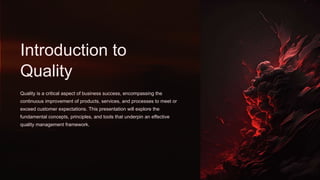
Introduction-to- Metrology and Quality.pptx
- 1. Introduction to Quality Quality is a critical aspect of business success, encompassing the continuous improvement of products, services, and processes to meet or exceed customer expectations. This presentation will explore the fundamental concepts, principles, and tools that underpin an effective quality management framework.
- 2. What is Quality? Quality is a multifaceted concept that encompasses the degree to which a product, service, or process meets or exceeds customer expectations. It involves delivering reliable, consistent, and fit-for-purpose offerings that fulfill the needs and requirements of the end-user. Quality is not just about the final output, but also the processes and systems that ensure excellence throughout the entire lifecycle.
- 3. Importance of Quality Quality is crucial for business success as it enhances customer satisfaction, improves brand reputation, and drives long-term profitability. High-quality products and services reduce costs, improve efficiency, and foster customer loyalty. Effective quality management also promotes a culture of continuous improvement, empowering employees and driving innovation.
- 4. Quality Principles Customer Focus Quality begins with understanding and meeting the needs of customers. Successful organizations place the customer at the center of their quality efforts. Process Approach Quality is achieved through the management and improvement of interconnected processes, not just inspection of final outputs. Continuous Improvement Quality is an ongoing journey, not a destination. Successful organizations embrace a culture of continuous learning and process refinement. Evidence-Based Decision Making Quality-driven decisions should be based on the analysis of data and information, not just intuition or assumptions.
- 5. Quality Management Systems Effective quality management systems, such as ISO 9001, provide a structured framework for organizations to consistently meet customer requirements and drive continuous improvement. These systems encompass processes for planning, controlling, and improving all aspects of product and service delivery. By implementing a quality management system, businesses can enhance efficiency, reduce costs, and foster a culture of excellence. This empowers employees, improves customer satisfaction, and positions the organization for long-term success in a competitive marketplace.
- 6. Quality Tools and Techniques Six Sigma A structured methodology that focuses on eliminating defects and improving process capability to meet customer requirements. Kaizen A philosophy of continuous, incremental improvements to processes and products, empowering employees to drive change. Statistical Process Control Utilizes statistical techniques to monitor and control process variability, identifying and resolving issues proactively. 5S Methodology A workplace organization and visual management system that enhances efficiency, safety, and quality through standardization.
- 7. Process Improvement Methodologies 1 Lean A systematic approach to reducing waste and optimizing efficiency in processes, with a focus on delivering more value to customers. 2 Six Sigma A data-driven methodology that aims to improve quality by identifying and eliminating the root causes of defects and variability. 3 Kaizen A Japanese philosophy of continuous, incremental improvements that empower employees to identify and implement small, positive changes.
- 8. Quality Control and Assurance Quality Control Quality control focuses on inspecting and testing products to ensure they meet defined standards and customer requirements. It involves implementing robust processes to identify and address defects before delivery. Quality Assurance Quality assurance encompasses the systematic processes and activities that ensure a product or service consistently meets quality standards. It emphasizes preventive measures to embed quality throughout the entire product lifecycle. Tools and Techniques Quality control and assurance leverage a variety of tools, including statistical process control, failure mode and effects analysis, and poka-yoke (mistake- proofing) to maintain and improve quality. Continuous Monitoring Effective quality control and assurance require continuous monitoring and data analysis to identify trends, detect issues, and drive ongoing improvements. This empowers organizations to anticipate and address problems proactively.
- 9. Continuous Improvement 1 Identify Recognize opportunities for improvement 2 Analyze Understand root causes and data 3 Improve Implement solutions and measure impact 4 Sustain Maintain gains and continue the cycle Continuous improvement is a core tenet of quality management, empowering organizations to consistently enhance their products, services, and processes. By embracing a culture of ongoing refinement, businesses can adapt to evolving customer needs, stay ahead of the competition, and drive long-term success.
- 10. Conclusion and Key Takeaways Quality Drives Success Implementing effective quality management practices is essential for businesses to deliver exceptional products and services, enhance customer satisfaction, and drive long-term growth and profitability. Continuous Improvement Quality is an ongoing journey, not a destination. Embracing a culture of continuous improvement empowers organizations to adapt to evolving customer needs and stay ahead of the competition. Quality Tools and Methodologies Leveraging powerful quality tools and methodologies, such as Six Sigma, Lean, and Kaizen, can help organizations optimize their processes, reduce waste, and deliver consistent, high-quality outcomes. Empowered Employees Engaging and empowering employees to contribute to quality improvement efforts is crucial for fostering a culture of excellence and driving sustainable change.